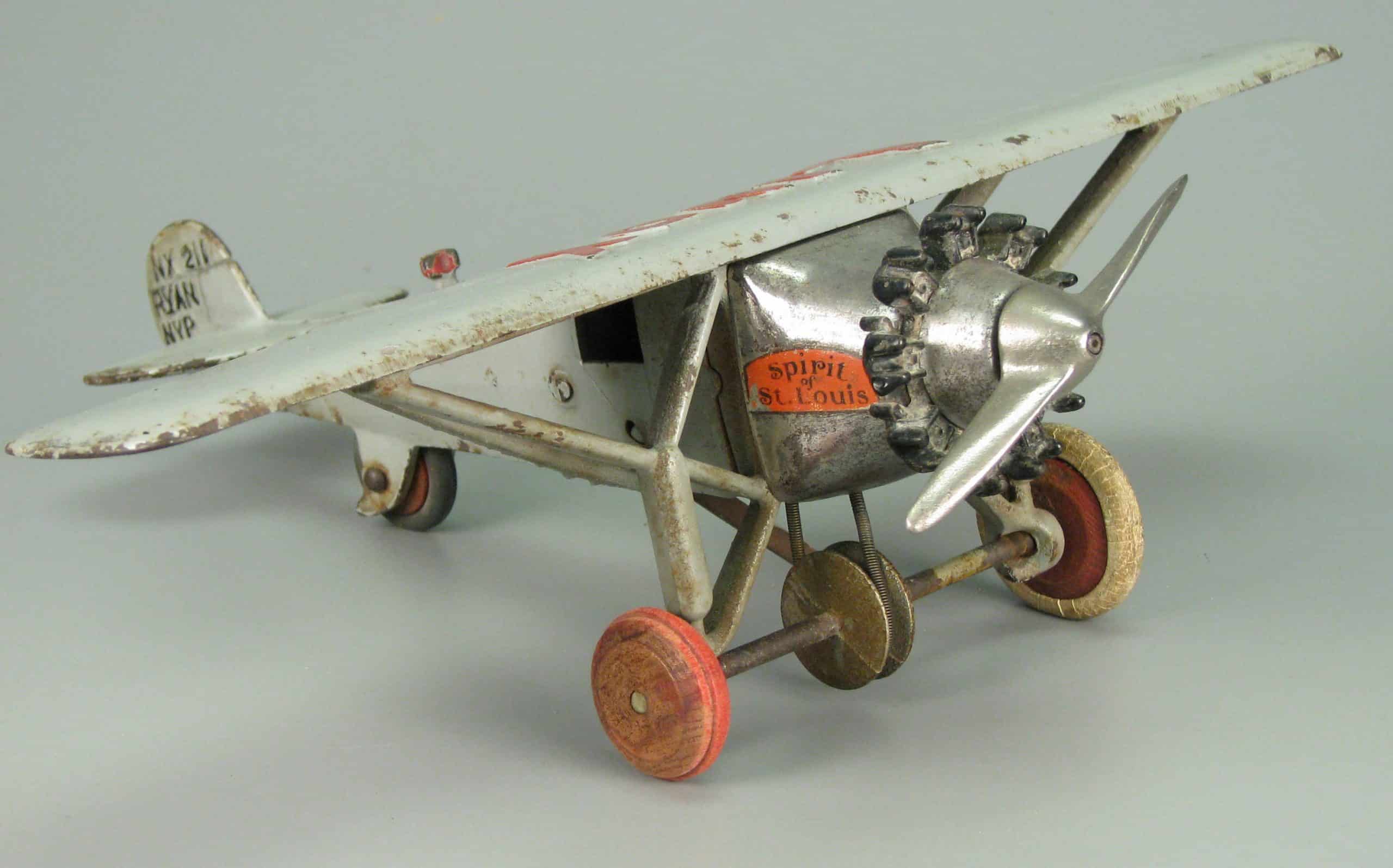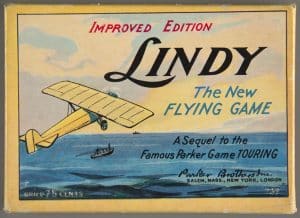 When Charles Lindbergh made his famous New York to Paris flight from May 20 to 21, 1927, he became an overnight celebrity. Parisians mobbed Le Bourget airport immediately after his landing and even tore bits of souvenir fabric from the wings of The Spirit of St. Louis, his trusted airplane. But Lindbergh’s arrival back in the United States cemented his reputation as a true American hero, with a ticker-tape parade and his image as the first Time magazine “Man of the Year.” Two months later, Lindbergh published his first book, the autobiographical “We,” named for his nearly spiritual bond with his plane during the record-breaking flight. While Wall Street financiers scrambled to invest money into the aviation industry, the American public, juiced on jazz and optimism in the late 1920s, scrambled for a piece of Lucky Lindy. And like so many other manufacturers, toy and game producers hurried to answer America’s call.
When Charles Lindbergh made his famous New York to Paris flight from May 20 to 21, 1927, he became an overnight celebrity. Parisians mobbed Le Bourget airport immediately after his landing and even tore bits of souvenir fabric from the wings of The Spirit of St. Louis, his trusted airplane. But Lindbergh’s arrival back in the United States cemented his reputation as a true American hero, with a ticker-tape parade and his image as the first Time magazine “Man of the Year.” Two months later, Lindbergh published his first book, the autobiographical “We,” named for his nearly spiritual bond with his plane during the record-breaking flight. While Wall Street financiers scrambled to invest money into the aviation industry, the American public, juiced on jazz and optimism in the late 1920s, scrambled for a piece of Lucky Lindy. And like so many other manufacturers, toy and game producers hurried to answer America’s call.
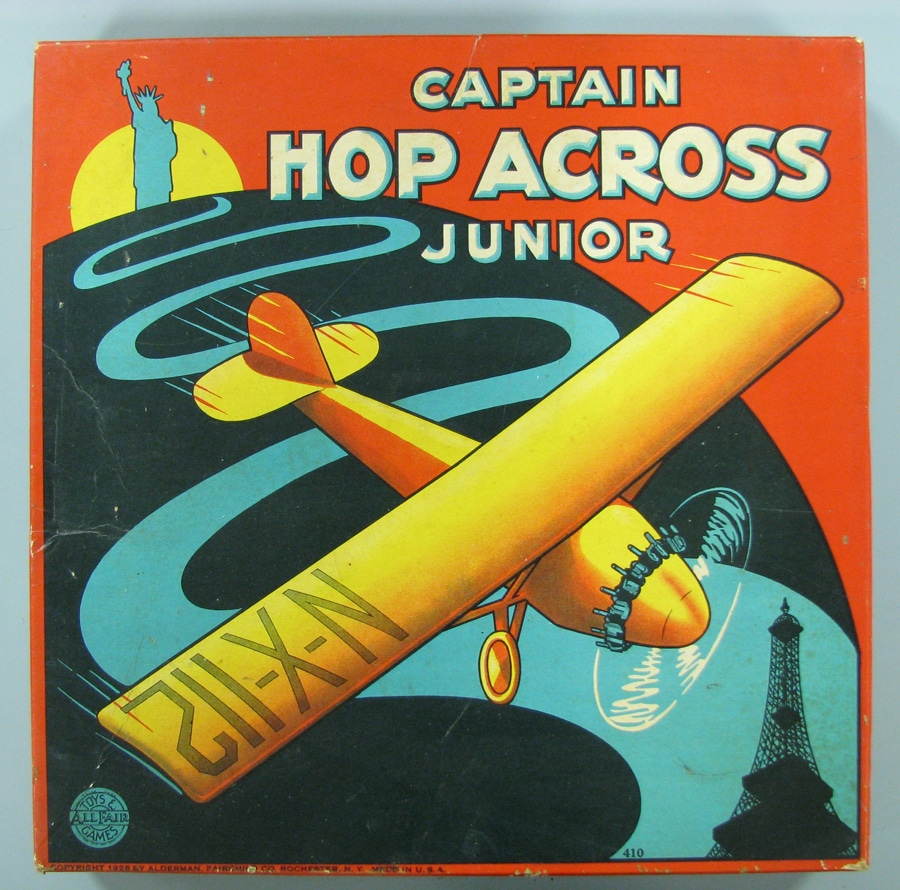 Toy makers knew that children found airplanes, flight, and heroes especially fascinating. Rochester’s All-Fair Games, known for bright and timely game designs, made the Captain Hop Across game in 1927. The game’s box lid shows The Spirit of St. Louis traversing a route from the Statue of Liberty to the Eiffel Tower and the propeller on a graphic of Lindbergh’s plane cleverly served as the game’s spinner.
Toy makers knew that children found airplanes, flight, and heroes especially fascinating. Rochester’s All-Fair Games, known for bright and timely game designs, made the Captain Hop Across game in 1927. The game’s box lid shows The Spirit of St. Louis traversing a route from the Statue of Liberty to the Eiffel Tower and the propeller on a graphic of Lindbergh’s plane cleverly served as the game’s spinner.
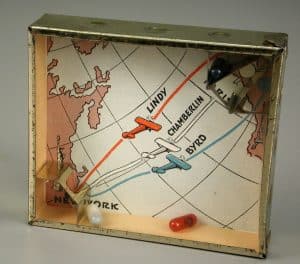 Other toys remind us of less-familiar history. A 1927 dexterity puzzle recalls that pilots Clarence Chamberlin and Richard Byrd intended to race Lindbergh from New York to Paris and compete for the $25,000 cash prize, but both were each delayed by unforeseen events. Chamberlin became the second pilot to fly across the Atlantic, but do any of us remember that today? Meanwhile, Parker Brothers brought out its own version of “We,” a game in which players move metal airplanes between “landing strips” by means of magnets on strings.
Other toys remind us of less-familiar history. A 1927 dexterity puzzle recalls that pilots Clarence Chamberlin and Richard Byrd intended to race Lindbergh from New York to Paris and compete for the $25,000 cash prize, but both were each delayed by unforeseen events. Chamberlin became the second pilot to fly across the Atlantic, but do any of us remember that today? Meanwhile, Parker Brothers brought out its own version of “We,” a game in which players move metal airplanes between “landing strips” by means of magnets on strings.
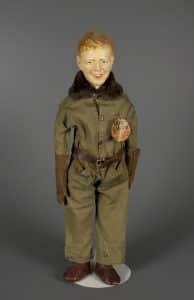 Lindbergh’s life took many turns, both for good and otherwise, after his heroic moment of glory. Still, Americans remembered him best for that one long, lonely flight. He stood as a symbol, not only of American initiative and courage, but of the country itself and the people themselves. New Jersey manufacturer Regal Doll produced a Lindbergh doll in 1928, complete with a furry collar and pilot’s gloves. Demonstrating America’s symbolic ownership, the company named the doll “Our Lindy.” To many, Lindbergh remained a model of American spirit, ingenuity, and bravery throughout the rest of the 20th century. And the toys help us all remember his early triumph.
Lindbergh’s life took many turns, both for good and otherwise, after his heroic moment of glory. Still, Americans remembered him best for that one long, lonely flight. He stood as a symbol, not only of American initiative and courage, but of the country itself and the people themselves. New Jersey manufacturer Regal Doll produced a Lindbergh doll in 1928, complete with a furry collar and pilot’s gloves. Demonstrating America’s symbolic ownership, the company named the doll “Our Lindy.” To many, Lindbergh remained a model of American spirit, ingenuity, and bravery throughout the rest of the 20th century. And the toys help us all remember his early triumph.
